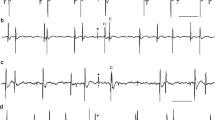Summary
Responses of muscle spindles of the iliofibularis muscle of the frogLitoria aurea have been recorded during single shock and repetitive stimulation of single functional motor axons. Repetitive stimulation of axons which innervated slow muscle, and on four occasions, axons which innervated twitch muscle, produced a large increase in the dynamic response of the spindle to a ramp-and-hold stretch. While extrafusal slow muscle did not respond to a single motor volley, some spindles did, especially if at the same time the muscle was being stretched. In an explanation of the effect of muscle stretch on responses of spindles to slow motor volleys it was proposed that stretch acted to reduce the internal motion in muscle fibres produced by a non-uniform distribution of sarcomere lengths. It was proposed that this kind of effect may account for dynamic fusimotor actions in all vertebrate spindles.
Similar content being viewed by others
References
Bessou P, Laporte Y, Pages B (1968a) A method of analysing the responses of spindle primary endings to fusimotor stimulation. J Physiol (Lond) 196: 37–45
Bessou P, Laporte U, Pages B (1968b) Frequencygrams of spindle primary endings elicited by stimulation of static and dynamic fusimotor fibres. J Physiol (Lond) 196: 47–63
Brown MC (1971a) A comparison of the spindles in two different muscles of the frog. J Physiol (Lond) 216: 553–563
Brown MC (1971b) The responses of frog muscle spindles and fast and slow muscle fibres to a variety of mechanical inputs. J Physiol (Lond) 218: 1–17
Brown MC, Matthews PBC (1966) On the sub-division of the efferent fibres to muscle spindles into static and dynamic fusimotor fibres. In: Andrew BL (ed) Control and innervation of skeletal muscle. University of St. Andrews, Dundee, pp 18–31
Emonet-Demand F, Laporte Y (1981) Muscle stretch as a way of detecting brief activation of bag1 fibres by dynamic axons. In: Taylor A, Prochazka A (eds) Changing views of the function of muscle receptors. Arnold, London, pp 67–76
Gray EG (1957) The spindle and extrafusal innervation of a frog muscle. Proc R Soc Lond [Biol] 146: 416–430
Gregory JE, Luff, AR, Morgan DL, Proske U (1978) The stiffness of amphibian slow and twitch muscle during high speed stretches. Pfluegers Arch 375: 207–211
Hulliger M (1979) The responses of primary spindle affErents to fusimotor stimulation at constant and abruptly changing rates. J Physiol (Lond) 294: 461–482
Huxley AF, Simmons RM (1972) Mechanical transients and the origin of muscular force. Cold Spring Harbor Symp Quant Biol 37: 669–680
Julian FJ, Morgan DL (1979) The effect on tension of non-uniform distribution of length changes applied to frog muscle fibres. J Physiol (Lond) 293: 379–392
Katz B (1949) The efferent regulation of the muscle spindle in the frog. J Exp Biol 26: 201–217
Katz B (1961) The terminations of the afferent nerve fibre in the muscle spindle, of the frog. Proc R Soc Lond [Biol] 243: 223–241
Lewis DM, Proske U (1972) The effect of muscle length and rate of fusimotor stimulation on the frequency of discharge in primary endings of muscle spindles in the cat. J Physiol (Lond) 222: 511–535
Luff AR, Proske U (1979) Properties of motor units of the frog iliofibularis muscle. Am J Physiol 236: 35–40
Matthews PBC, Westbury DR (1965) Some effects of fast and slow motor fibres on muscle spindles of the frog. J Physiol (Lond) 176: 178–192
Proske U, Rack PMH (1976) Shortrange stiffness of slow fibres and twitch fibres in reptilian muscle. Am J Physiol 231: 449–453
Smith RS (1964a) Activity of intrafusal muscle fibres in muscle spindles ofXenopus laevis. Acta Physiol Scand 60: 223–239
Smith RS (1964b) Contraction in intrafusal muscle fibres ofXenopus laevis following stimulation of their motor nerves. Acta Physiol Scand 62: 195–208
Smith RS, Koles ZJ (1974) Mechanical properties of muscle spindles inXenopus laevis. Kybernetik 15: 91–98
Author information
Authors and Affiliations
Additional information
Financial assistance was provided by a grant from the National Health and Medical Research Council of Australia, Grant No. 78/5721
Rights and permissions
About this article
Cite this article
Proske, U. The responses of frog muscle spindles during stimulation of slow motor axons. Exp Brain Res 45, 364–370 (1982). https://doi.org/10.1007/BF01208596
Received:
Issue Date:
DOI: https://doi.org/10.1007/BF01208596




